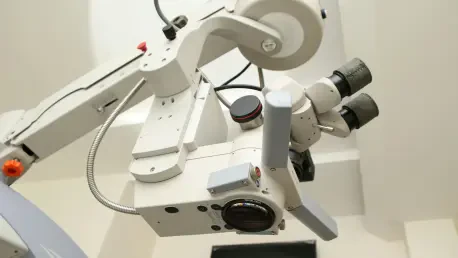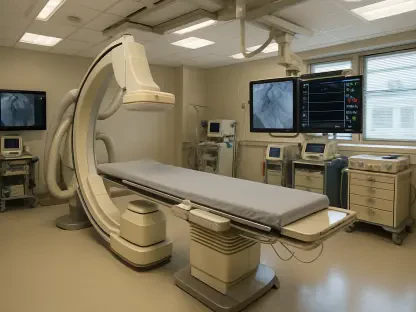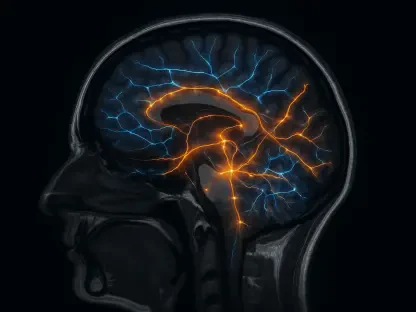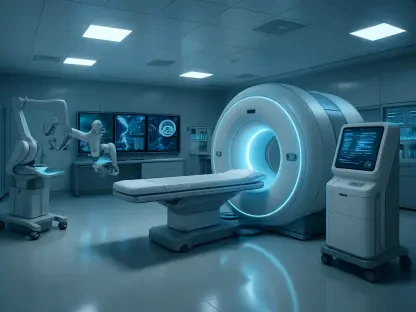The medical diagnostics landscape is witnessing a groundbreaking shift with GE HealthCare’s innovative integration of artificial intelligence into imaging technology. Recently, the U.S. Food and Drug Administration granted 510(k) clearance to GE HealthCare’s Aurora nuclear medicine system and Clarify DL technology, highlighting a significant leap in diagnostic technology. This approval signifies the ongoing evolution of healthcare tools that aim to provide greater precision in diagnostics and streamline clinical workflows. Utilizing dual-head single-photon emission computed tomography (SPECT) and computed tomography (CT), the Aurora system is designed to address the high demand for sophisticated systems capable of accurate and efficient diagnostics. Central to its design is the 40mm detector, offering double the coverage compared to conventional hybrid systems’ CT detectors. Enhanced by 128-slice and intelligent imaging options, it supports a wide array of clinical applications, notably in cardiology, oncology, and neurology. This positions Aurora as not only a versatile tool but also a critical asset in diverse clinical areas.
Advancements in Diagnostic Precision
GE HealthCare’s Aurora system represents a significant advancement in diagnostic precision, firmly positioning itself as a versatile tool across multiple medical disciplines. Its extensive clinical application range includes cardiology, oncology, and neurology, sectors characterized by complex diagnostic needs. The innovation lies in the Aurora system’s unique use of 5/8-inch crystal sodium iodide (NaI) detectors, which are particularly effective in theranostics. This advancement marks a notable improvement in the ability to conduct thorough analyses and deliver precise treatment solutions. Meanwhile, the Clarify DL technology elevates bone SPECT imaging quality through deep learning, achieving enhanced image clarity without necessitating increased injected dose or prolonged scan time. These technologies together facilitate better detection capabilities and clinical workflow integration, crucial for improving patient outcomes. University Hospitals in Ohio stands at the forefront of this technological revolution, being the first in the United States to implement this system.
Enhancing Clinical Workflow and Patient Care
A significant benefit of GE HealthCare’s new technologies is their seamless integration into clinical settings, improving imaging capabilities without disrupting existing workflows. This approach reflects a broader trend toward marrying advanced technological solutions with routine medical practices to enhance efficiency and effectiveness. A clinical evaluation conducted on Clarify DL revealed its image resolution to be superior in 98% of nuclear medicine bone SPECT imaging exams. Such results underscore the potential of AI-enhanced imaging technologies to transform traditional diagnostic practices. These developments, championed by GE HealthCare’s CEO and President Jean-Luc Procaccini, underscore a commitment to empowering clinicians in delivering precision medicine and patient-centered care. By focusing on improving patient outcomes, the company’s strategies align with overarching trends in personalized healthcare and advanced diagnostic imaging technologies.
The Future Direction of Diagnostic Imaging
GE HealthCare is revolutionizing medical diagnostics by integrating artificial intelligence into its imaging technology. Recently, the U.S. Food and Drug Administration granted 510(k) clearance to GE HealthCare’s Aurora nuclear medicine system and Clarify DL technology, marking a new frontier in diagnostic innovation. This approval underscores the ongoing development of healthcare tools aimed at enhancing diagnostic precision and optimizing clinical workflows. The Aurora system employs dual-head single-photon emission computed tomography (SPECT) alongside computed tomography (CT) to meet the growing demand for sophisticated systems that deliver accurate, efficient diagnostics. Its core feature is a 40mm detector that doubles the coverage available through conventional hybrid systems’ CT detectors. Enriched by 128-slice and intelligent imaging capabilities, it spans a wide range of applications in cardiology, oncology, and neurology, positioning Aurora as a versatile and essential asset across diverse clinical fields.









